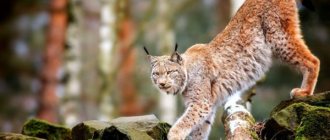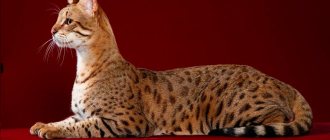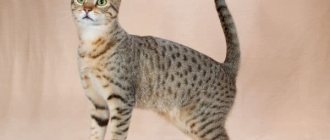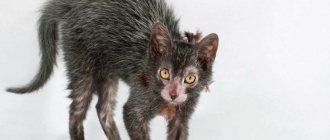The feline family is not only about cute furry animals that purr and rub against their owner's legs. Even domestic cats can reach speeds of up to 40 km/h over short distances, and wild cats are among the fastest animals on the planet. Moreover, if we consider that they are all predators, this means they are also among the most dangerous.
Dune cat
The sand cat is the smallest representative of wild cats, and therefore is often endangered by other predators. Capable of chasing prey at a speed of 40 km/h for 10 km.
Egyptian Mau
Although the Egyptian Mau has long been domesticated, the wild nature of the cat still takes over. From the time when her ancestors had to hunt for survival, Mau learned to run at a speed of 58 km/h.
Leopard
For him, high speed is not particularly important, since he does not hunt on the ground. This spotted wild cat prefers to watch for prey, hiding in the foliage of trees, and overtake it with one sharp jump. He has strong muscular legs, and his running speed can reach 60 km/h.
Tiger
A very large cat, capable of chasing prey at speeds of 60 km/h. But a weight of more than 300 kg and a 3-meter body length often interfere with successful hunting.
Puma
Like the lion, its close relative is large in size, but is capable of maintaining a speed of 75 km/h. This gives the puma an advantage during hunting, but its large dimensions do not allow it to maintain speed for a long time.
Snow Leopard
The handsome snow leopard can only be found high in the mountains. He not only runs fast, but also jumps. The length of his jump can be 6 meters and the height - 3 meters. In terms of running speed, the leopard is not inferior to the lion, while the animal’s long tail acts as a steering wheel and helps to turn in different directions.
a lion
The king of beasts is a fairly large animal with a body weight of more than 2 centners. Therefore, it is difficult for him to maintain high speed over long distances. At a speed of about 80 km/hour, a lion can run no more than 20 meters. When hunting, this predator prefers to lie in wait for its prey and pounce on it.
Panther
The panther is not only fast, but also the most dexterous and dangerous predator.
This wild cat is unusually graceful and, unlike its counterparts, hunts near human settlements. The black beauty is capable of running at a speed of 88 km/h and is particularly bloodthirsty. The objects of her hunt can be not only animals, but also humans.
Jaguar
This animal can move at a speed of 90 km/hour. Jaguars are large. The body, without a tail, can reach a length of more than 2 meters. Because of their size, it is quite difficult for them to pursue prey at high speed for a long time.
Cheetah
Considered the fastest animal on Earth. A wild cat has a powerful, muscular body without an ounce of excess fat. The weight of a cheetah is 70 kg, and the speed that the animal develops exceeds 110 km/h.
The predator will not sit in ambush and guard the prey. The cheetah needs a few tugs and the prey will be in its claws. Just two seconds are enough for this “savage” to develop lightning speed, and the length of the jump can reach 8 meters.
Fifth place – Snow Leopard
The animal has a second name - snow leopard (snow cat). The predator is considered rare and incredibly beautiful. He is capable of running a short distance at speeds of up to 80 km/h . The leopard jumps far - 6 meters in length.
The predator has short but incredibly powerful legs with developed muscles. The tail helps change direction when running. This is convenient during hunting, because the prey does not have a chance.
Characteristics of the snow leopard:
- Length – up to 2.3 meters.
- Weight – up to 55 kg.
- Life expectancy in the natural environment is 13 years, in captivity – 21 years.
I recommend: Buy a kitten (pedigreed): how to do it correctly
The snow leopard is the highest mountain animal on Earth. It can be found at an altitude of up to 6 km above sea level.
Summarizing
Even the slowest domestic cats can reach impressive speeds of up to 30 km per hour! Some cats would rather not waste their days so quickly, but trust us, if they have to, they are more than capable.
Other cats that are active and spend most of the day playing can easily reach a top speed of about 50 km per hour. Considering that this is the same speed as the world record for a human sprinter, this is impressive.
This is all because of the cat's incredibly powerful hind legs and flexible spines. So, the next time your indoor cat curls up next to you, take a moment to appreciate the incredible anatomy that allows them to run so fast.
Posted by Emma Stenhouse Emma is a freelance writer specializing in pets, outdoor activities and the environment. Originally from the UK, she lived in Costa Rica and New Zealand before moving to a small holding in Spain with her husband, their 4-year-old daughter and their dogs, cats, horses and birds.
Leopard
The puma (or mountain lion) consistently occupies sixth position in the world top of the fastest cats. These predators reach speeds of up to 75 km/h over short distances.
I recommend: A cat or a cat – which is better to have in an apartment?
These large animals reach two meters in length (including tail). The weight of these cats reaches 100 kg. A well-developed muscular system and low weight contribute to the speed and agility of mountain lions. They can accelerate to 75 km/h.
Females are smaller in size than males. But, at the same time, they are not inferior to them in agility and speed.
Egyptian Mau
The fastest representatives of domestic cats are considered to be the Egyptian Mau (“Mau” means cat). The maximum record of these miniature darlings is acceleration to 58 km/h (over short distances). All zoologists claim that if these animals had larger dimensions, they could well compete with the cheetah for the title of the fastest animal on the planet.
The fastest wild cat breeds
The cat family includes 41 species of wild cats. They all vary in size, color and behavior. And among them we can single out the fastest.
Cheetah and jaguar
In appearance, cheetahs resemble the graceful Russian greyhound. Like these dogs, cheetahs have blunt claws that hardly retract, they also do not climb trees well, they prefer to stalk their prey rather than sit in ambush, and they never feed on carrion.
The jaguar's body length can reach up to 180 cm in length, and its weight can be more than 90 kg. It is very similar to a leopard in its appearance, but is much larger in size.
Panther and lion
the lion is called the “king of beasts.” The weight of individual individuals can be above 250 kg. It is noteworthy that, despite all their external greatness, lions cannot be classified as especially hardy animals.
I recommend: The largest domestic cats in the world: TOP breeds
Snow leopard and puma
The snow leopard has adapted to live in the harsh conditions of the highlands. The highest point at which a snow leopard was spotted is 6 km above sea level.
Indoor and outdoor “runners”
Cats are far from running marathons; they are sprinters by nature.
It is quite logical that cats who live on the street, or who often find themselves there, need good athletic shape. They hunt birds and mice, which are not so easy to catch if you are physically unprepared. And most importantly, they often have to escape from dogs, otherwise they won’t survive. Domestic “fluffies” generally live freely - they only remember hunting as a game, when the owners offer them to catch a toy mouse or a bow on a string. Their bowl is always full, so there is no need to get food for themselves, and in general, the owners take care of everything. And you have to save yourself only from the master’s slipper.
In any case, a cat cannot run at high speed for long. If she does this to escape, she usually climbs a tree or otherwise hides from danger. But, if there is no shelter, then the animal may begin to suffocate and even die, since its heart is not adapted to such stress.
Cheetah | Speed up to km/h
The cheetah is the fastest cat, possessing not only the fastest speed of any feline, but of all animals in the world! In just three seconds, a cheetah can run up to 112 km/h. The maximum take-off run over short distances is 130 km/h. He has a slender, graceful body and well-developed muscles. The large predator has practically no fat layer, and its weight, despite its dimensions, reaches a maximum of only 65 kilograms. It is his aerodynamic body structure that allows him to develop such speed. During the maximum run, this predator’s breathing rate develops up to 150 times per minute. In addition, the cheetah is able to change the direction of its run with lightning speed. Thus, the hunter's prey has virtually no chance of survival.
121 9
What does a liger eat?
Photo: Liger cat
The liger eats a lot of meat, so the costs of keeping it in zoos are enormous. To maintain the genetic potential of a predator, ligers are regularly introduced to live prey so that the cats can hunt and learn the nuances of wild life. In general, a liger eats from 10 to 15 kg of meat, depending on its gender, age and size.
The following “dishes” are most often served to ligers:
- chickens, including live ones, which ligers kill on their own;
- rabbits, also sometimes live;
- processed beef meat, offal, heads and hooves with hard bones for ligers to wear down their teeth;
- eggs, in particular - white, crushed with shell;
- fat milk.
Ligers do not refuse raw fish and play with it with pleasure. Also, large cats are often offered watermelons: they play with them and, in the end, bite them. Plant food is included in the daily diet of ligers. They are given all kinds of vitamin mixtures to keep the big cats healthy. Such mixtures are especially important for babies, who need to strengthen the skeleton and prevent possible diseases.
There is always a lot of fresh growing grass in the liger's enclosure. Big cats often lie among tall grass and bite it - this indicates the need for vitamins in the body of a big cat. They are offered peaches, apricots, tomatoes, cucumbers, lettuce and many other fruits and vegetables as natural vitamins.
Features of character and lifestyle
Photo: Hybrid liger
The character of ligers can be called versatile. These cats have inherited behavioral traits from both their lion father and tiger mother. From lions, ligers adopted a love for social groups. Lions have a very positive attitude towards all big cats. They easily get along with each other and fit into prides of lions. In relation to other cats, ligers are non-confrontational, love affection, and strive to be close to other relatives.
On the other hand, ligers have adopted from tigers the tendency to mark territory and defend it. The liger has a flock, which he perceives as family, but he also has his own corner, which belongs only to him. Female ligers are especially prone to this, just like tigresses do. Also, from tigers, ligers inherited a love of water and swimming. They willingly frolic in ponds, drag prey there, dive and simply lie in the water - lions have a dislike for water and even fear of bodies of water.
The liger is also similar to the tiger in that it can easily withstand low temperatures. Tigers are adapted to cold weather - their fur is known for its dense undercoat, which the tigress passed on to their children - the ligers. At the same time, ligers do not suffer from heat, since their fur provides competent thermoregulation. In severe frosts, ligers happily roll around in the snow, and in hot weather they lie in the water.
Social structure and reproduction
Photo: Liger cubs
Male ligers are absolutely sterile, but females have a chance of having offspring, although it is very low
This does not negate the fact that female ligers have a period of estrus, during which they show increased attention to males of all species: ligers, tigers and lions. A ligress can only have offspring from lions. In search of a partner, a female liger is even able to climb over the high fence separating her from the enclosure with other large cats.
Regardless of whether she ends up with a tiger or a lion, the female’s behavior will be the same.
A ligress in heat marks her territory, letting the males know that she is ready to mate. In zoo conditions, keepers do not allow any exhibition tournaments between male tigers or lions, so the female, as a rule, does not choose a partner for herself - he is simply released into her enclosure. Big cats have very beautiful foreplay. They affectionately rub their heads against each other, lie next to each other for a long time and lick each other's fur. For lions, such foreplay is faster, but for tigers it can last more than a day. After mating, the female and male separate.
Pregnancy lasts about 110 days. As a result, the female gives birth to one or two cubs, and most often these are the same infertile males. The descendants of a lion and a ligress are called liligers, and this is an extremely rare case when the offspring are born alive and healthy. As a rule, cubs do not survive until three months. In theory, female liligers could have offspring with lions, but lions have a strong genetic potential, which is why the resulting offspring will not resemble ligers - they will be ordinary lion cubs. Often, female ligers do not have milk, which is why zookeepers feed their offspring.
Where does he live?
Jaguars are huge and strong cats that live in the forests and meadows of Central and South America. They are the largest animals in the New World. The jaguar's habitat extends from Mexico to Argentina and Paraguay.
Despite its large size, strength and agility, life is not easy for the jaguar. Although in the wild it is at the top of the food chain, it is forced to defend its own territory. The size of such a territory is large - about 100 km. Females have smaller territories than males.
The wild cat is very dangerous and protects its territory in every possible way. She will not let anyone pass by her, so animals and people should beware of meeting her.
READ Pet care aquarium fish food
Jaguars live not only in dark forests, they also live in other areas:
- shroud;
- mountain forests;
- marshy area;
- ocean coast;
- desert.
In hot weather, they prefer to swim in shallow waters, as these animals are considered excellent swimmers. Sometimes they settle very close to the water to catch fish. To catch, they use their tail, dipping it into the water instead of a fishing rod. So, they lure prey.
The population of the species has decreased several times, and in some countries they have been completely exterminated. This is associated with hunting animals, since their skin is highly valued. For this reason, the jaguar is listed in the Red Book. In the wild, life expectancy is 12-15 years, in captivity it is several years longer.
Lifestyle
There are 9 species of jaguars in the world and each of them lives in a different area. One of the Texas species has now been completely exterminated. The most unusual is the black jaguar, which is often confused with a panther. In fact, such an individual has an atypical variant of genetic coloring.
In terms of lifestyle, all species of these predators are very similar. These are nocturnal animals that live alone. Each has its own territory, although a female with several cubs can often be seen. Having matured, they will leave their mother and go to explore new areas, because they prefer to live independently.
With the onset of the mating season, animals can live together. However, there is no specific breeding season for jaguars. During the mating season, predators gather in groups where the female chooses a mate. After that, she leaves the territory and goes to where the male lives. She carries the cubs for 3 months.
Predators necessarily periodically bypass the borders of their territory. Thanks to their high speed, they manage to do this quickly. Sometimes jaguars may overlap, but they react to each other absolutely calmly. When meeting other predator cats, they are hostile.
Animal Jaguar / Jaguar animal
Liger
The result of the love between the tigress Isla and the lion Arthur, who shared a common enclosure at the American theme park Jungle Island, became a kitten, which was later destined to top the ranking of the largest cats on the planet. Having reached maturity, the liger Hercules surpassed his parents in size. His height is 186 cm, weight - 410 kg. Standing on his hind legs, the giant reaches the roof of a double-decker bus. The gaping mouth is as wide as the shoulder girdle of an adult man.
Hercules is not the only representative of the hybrid genus. In 1973, the Guinness Book of Records added a record of a giant weighing 798 kg from a South African nature park. In 2004, a female was born at the Novosibirsk Zoo - the result of crossing an African lion and a Bengal tigress. It is impossible to meet a liger in natural conditions - tigers and lions have different habitats.
Description of appearance
Jaguars belong to a species of predatory mammals of the cat family. These animals are the largest predators living on the American continent. Among the largest representatives of predatory animals they occupy an honorable third place.
The body of some animals can reach a length of 2 meters. Such specimens are found in the jungles of Brazil. The average weight of a jaguar is 80-90 kg, but there are animals whose weight exceeds 100 kg. Outwardly, they are very similar to leopards, but much larger in size. Males are larger in weight and size than females.
The height at the withers of the predator reaches 80 cm, and the length of the tail is 50-80 cm. This strong, large and agile animal has a smooth-haired skin. The fur is short and the head has rounded ears. The structure of the skull is very similar to tigers. The color of the animal can be very diverse. Typically, the coat color is dominated by shades of rich red and sandy tones. The lower part of the body and soles are white. The entire body is decorated with dark spots.
These cats have well-developed all senses:
- amazing hearing;
- sharp vision.
The jaguar's whiskers are the main organ of touch. Thanks to this, the animal moves almost silently at night in the jungle.
The black jaguar is also common in nature. In appearance, this cat is one of the most beautiful in this family. The weight of a black jaguar can reach 120 kg, and the length of its tail is up to 1 meter. It fascinates with its beauty, so local residents believe that the black jaguar is endowed with hypnosis. These jaguar cats are often confused with panthers. They prefer wild spaces. The panther jaguar loves to live in tropical forests.
Reproduction of predators
Female cheetahs lead a solitary lifestyle, with the exception of periods spent with cubs. Male predators usually live together in groups of several individuals. They constantly fight for territory and the females that live on it. A pair of males usually maintains territorial positions for about six months. If three males live together, then the territory can remain theirs for up to 2 or more years.
After the female begins to ovulate, the cheetah stalks her for some time before mating. The gestation period lasts about 90 days, and females give birth to 2 to 6 cubs. The first time after birth, kittens are completely helpless, which makes them easy prey for other predators. Feeding with mother's milk lasts up to eight months of age, and the cubs live with their mother for up to 12-20 months. The further existence of the animal implies independent satisfaction of all vital needs.











